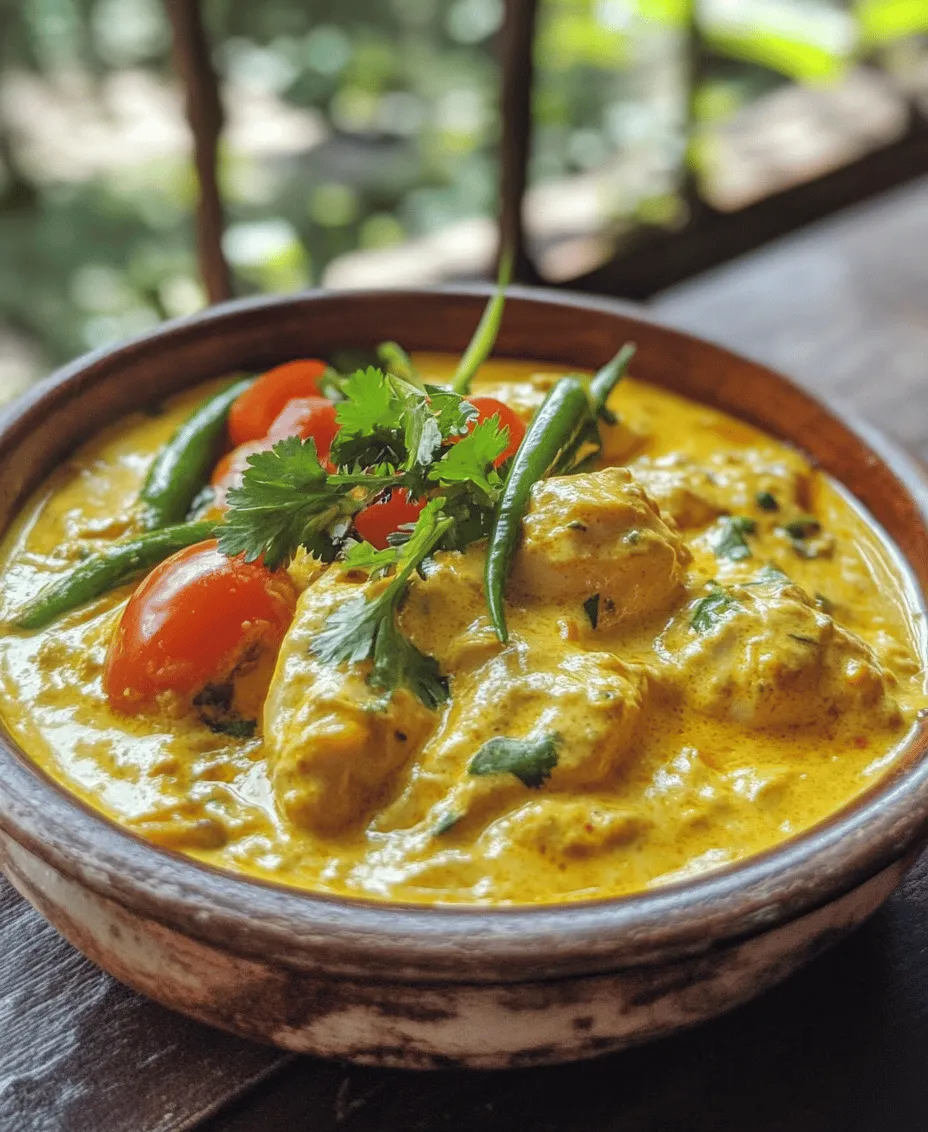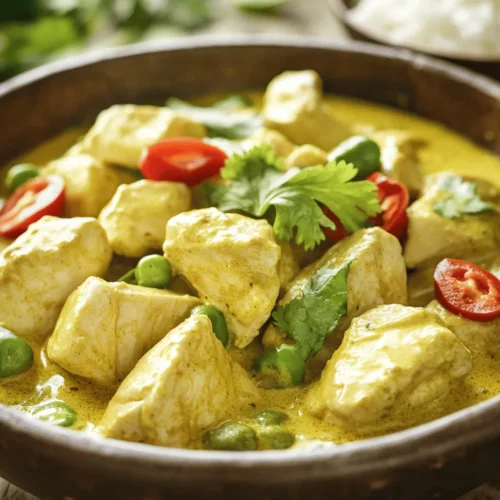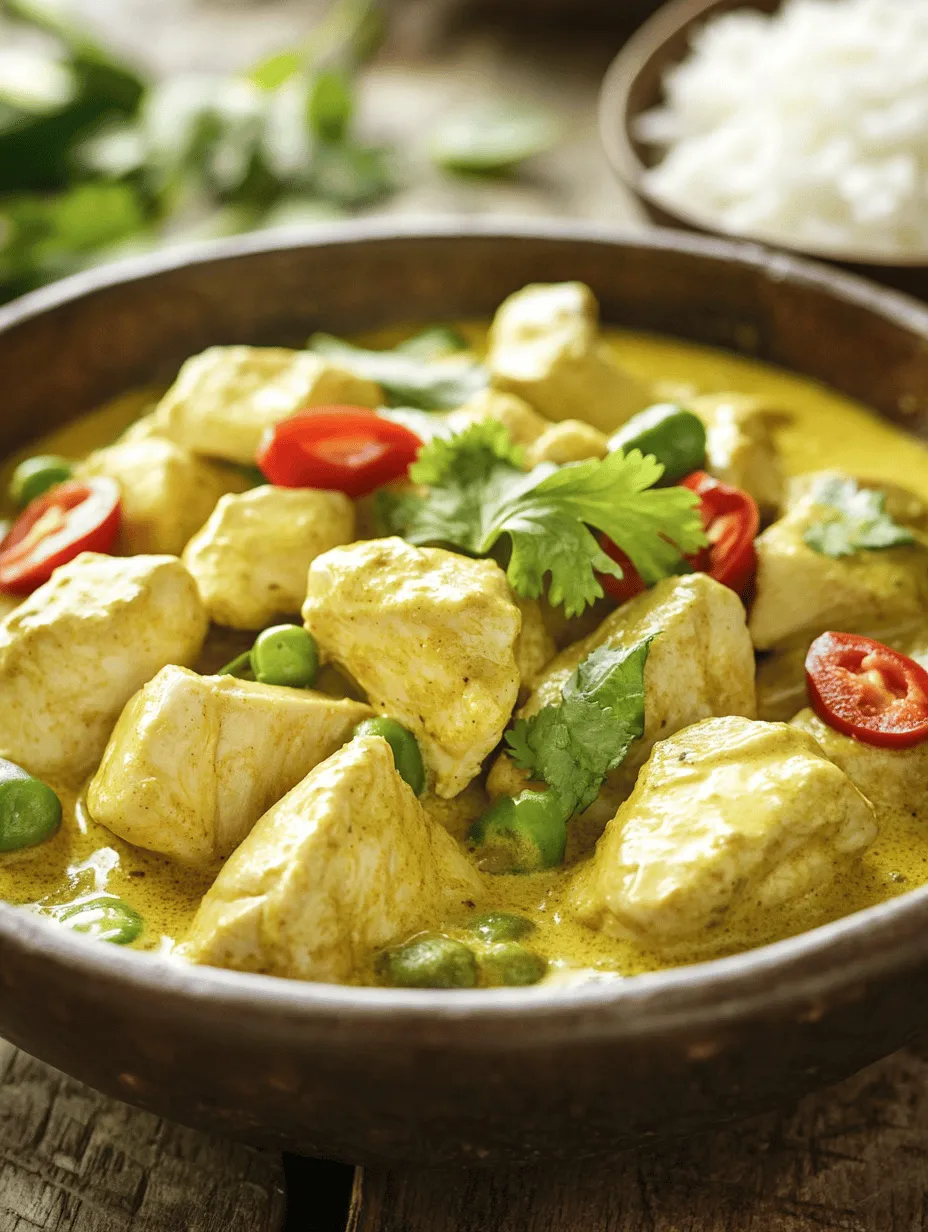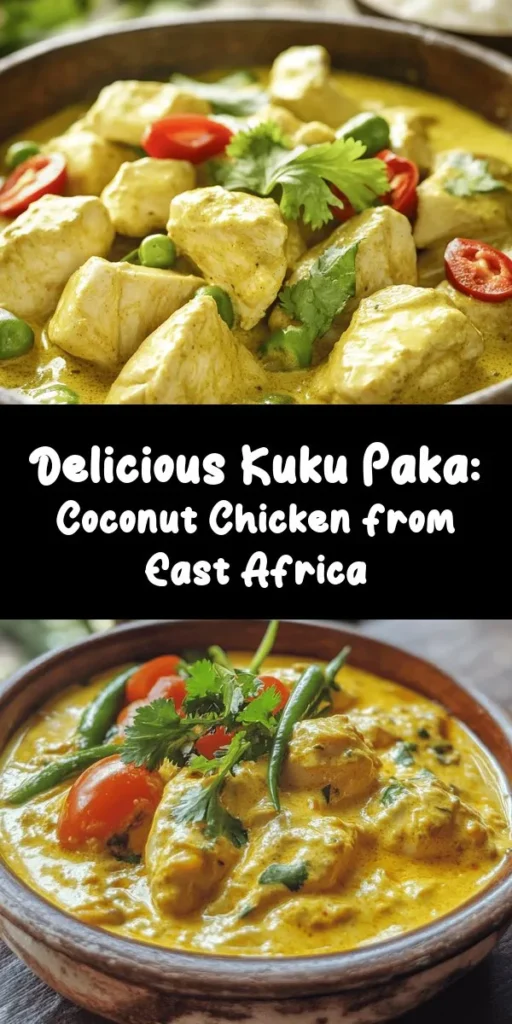Kuku Paka, a delightful East African dish, is a culinary gem that embodies the vibrant flavors and rich traditions of the region. This delectable chicken recipe combines aromatic spices with the creamy richness of coconut milk, creating a comforting yet exotic meal that warms the heart and tantalizes the taste buds. Originating from the Swahili coast, Kuku Paka is not just a dish; it is a representation of East African culture, showcasing the harmonious blend of influences that have shaped the cuisine over centuries.
In this article, we will delve into the history and cultural significance of Kuku Paka, explore its unique ingredients, and provide you with a detailed step-by-step guide to preparing this mouthwatering coconut chicken delight. Whether you are a seasoned cook or a curious beginner, this recipe will expand your culinary repertoire and bring a taste of East Africa to your kitchen.
The Cultural Heritage of Kuku Paka
Exploring the Origins of Kuku Paka
The roots of Kuku Paka can be traced back to the coastal regions of East Africa, particularly Kenya and Tanzania, where Swahili culture flourished. The term “Kuku” translates to “chicken” in Swahili, while “Paka” means “to coat” or “to spread,” referring to the way the chicken is enveloped in a luscious coconut sauce. The dish showcases the fusion of indigenous ingredients with those brought by traders and explorers, reflecting the diverse cultural tapestry of the region.
Historically, the coastal trade routes facilitated the exchange of not only goods but also culinary practices. Spices from the Indian subcontinent, coconuts from tropical islands, and local produce all converge in Kuku Paka, making it a symbol of the area’s rich gastronomic heritage. Over time, this dish has become a staple in many East African households, often served at celebrations, family gatherings, and communal meals.
Understanding the Role of Coconut in East African Cuisine
Coconut is a cornerstone of East African cooking, particularly in coastal areas where palm trees flourish. The versatility of coconut allows it to be utilized in various forms—fresh, grated, milk, or oil—each contributing its unique flavor and texture to dishes. In Kuku Paka, coconut milk plays a critical role, adding a creamy richness that balances the spices and enhances the overall flavor profile.
The use of coconut milk is not only about taste; it also reflects the cultural practices of the region. Coconuts are often harvested and processed in communities, fostering a sense of togetherness and shared resources. As such, Kuku Paka is more than just a meal; it is an experience rooted in community and tradition.
The Influence of Spices in East African Cooking
Spices are the heartbeat of East African cuisine, with their origins rooted in the ancient trade routes that traversed the Indian Ocean. Kuku Paka is a prime example of how spices can elevate a dish, turning simple ingredients into an explosion of flavors. Common spices found in Kuku Paka include cumin, coriander, turmeric, and garam masala, each contributing distinct notes that define the dish.
The careful selection and combination of spices not only enhance the flavor but also reflect the culinary techniques passed down through generations. In East African kitchens, the art of spice blending is revered, and each family may have its unique twist on traditional recipes, making Kuku Paka a dish that can vary widely in flavor and presentation.
Ingredients That Make Kuku Paka Unique
Overview of Key Ingredients
To create a delicious Kuku Paka, several key ingredients are essential. Each component plays a vital role in achieving the perfect balance of flavors, ensuring that the dish is both aromatic and satisfying. The main ingredients include:
– Chicken: The star of the dish, providing protein and a base for the sauce.
– Coconut Milk: Offers creaminess and a subtle sweetness that complements the spices.
– Onions, Garlic, and Ginger: The aromatic trio that forms the flavor foundation of the dish.
– Spices: Cumin, coriander, turmeric, and garam masala for depth and complexity.
– Fresh Ingredients: Green chilies, tomatoes, and cilantro for freshness and brightness.
– Lemon Juice: Adds acidity to balance the richness of the coconut milk.
The Role of Chicken in the Dish
Chicken is the primary protein in Kuku Paka, and its preparation is crucial to the dish’s success. Traditionally, bone-in, skin-on chicken is used, as it adds flavor and moisture during cooking. The chicken is often marinated in spices and lemon juice before cooking, allowing the flavors to penetrate the meat and enhance its tenderness.
For those looking to substitute, alternatives such as bone-in turkey or even tofu can be used, although the flavor profile will shift. Regardless of the choice, the marination process remains vital to achieving a deeply flavorful dish.
A Deep Dive into Aromatics: Onions, Garlic, and Ginger
The aromatic trio of onions, garlic, and ginger forms the backbone of Kuku Paka’s flavor. Each of these ingredients contributes its unique characteristics:
– Onions: Sweet and savory, onions provide a foundational flavor that enhances the overall dish. When sautéed, they caramelize and develop a rich sweetness, adding depth to the sauce.
– Garlic: Known for its pungent aroma, garlic infuses the dish with a savory kick. It is often added early in the cooking process to allow its flavors to mellow and blend seamlessly with the other ingredients.
– Ginger: With its zesty and slightly spicy profile, ginger brightens the dish and adds a fresh note. It complements the richness of the coconut milk and balances the warmth of the spices.
Understanding the Spice Blend: Cumin, Coriander, Turmeric, and Garam Masala
The spice blend in Kuku Paka is integral to its identity, with each spice bringing something unique to the table:
– Cumin: Earthy and nutty, cumin adds warmth and complexity. It is often toasted before use to enhance its flavor.
– Coriander: With its citrusy notes, coriander brightens the dish and adds a layer of freshness.
– Turmeric: Known for its vibrant yellow color, turmeric contributes an earthy flavor and is renowned for its health benefits.
– Garam Masala: This aromatic blend varies by region and family but typically includes spices like cardamom, cloves, and cinnamon, adding warmth and depth.
The Importance of Coconut Milk
Coconut milk is the star ingredient in Kuku Paka, offering a rich and creamy base that binds the flavors together. It is made by blending fresh coconut meat with water, resulting in a smooth and luscious liquid that enhances the dish’s overall texture.
In addition to its delicious taste, coconut milk is a significant aspect of East African cuisine, often used in curries, stews, and desserts. Its natural sweetness balances the heat from the spices, making it an essential component in Kuku Paka.
Fresh Elements: Green Chilies, Tomatoes, and Cilantro
Fresh ingredients add brightness and vibrancy to Kuku Paka, elevating the dish to new heights.
– Green Chilies: These provide heat and a fresh kick, allowing you to customize the spice level according to your preference. They are typically added early in the cooking process to infuse their flavor into the sauce.
– Tomatoes: Juicy and tangy, tomatoes add acidity and balance the richness of the coconut milk. They can be used fresh or canned, depending on availability and preference.
– Cilantro: Fresh cilantro is often used as a garnish, bringing a burst of color and a refreshing herbal note that brightens the dish.
Balancing Flavors with Lemon Juice and Seasoning
To achieve the perfect Kuku Paka, balancing flavors is key. Lemon juice plays a crucial role in this, adding acidity that cuts through the richness of the coconut milk and brightens the overall flavor profile. This acidity enhances the other ingredients, making each bite more vibrant.
When seasoning, salt and pepper should be added gradually, allowing you to adjust according to taste. The right balance will elevate your dish, ensuring that the spices, aromatics, and richness of the coconut milk shine through.
Preparing Kuku Paka: Step-by-Step Instructions
Preparation of Ingredients
Before diving into cooking, proper preparation of ingredients is essential for a smooth cooking process. Here are the steps to prepare for making Kuku Paka:
1. Marinate the Chicken: Begin by marinating the chicken pieces in a mixture of lemon juice, salt, and half of the spice blend (cumin, coriander, turmeric, and garam masala). Allow it to sit for at least 30 minutes to absorb the flavors.
2. Chop Aromatics: Finely chop the onions, garlic, and ginger. Set these aside for later use.
3. Dice Fresh Ingredients: Chop the green chilies and tomatoes, and set aside. If you prefer a milder heat, remove the seeds from the chilies before chopping.
4. Prepare Coconut Milk: If using fresh coconut, grate the coconut meat and blend it with water to make coconut milk. If using canned coconut milk, shake well before opening.
5. Gather Seasonings: Have the remaining spices and seasoning at hand for easy access during cooking.
With all ingredients prepped and ready, you are now set to embark on the cooking journey of Kuku Paka, where the magical combination of flavors will come together to create a dish that is not only delicious but also steeped in rich cultural heritage.

Sautéing Aromatics for Flavor Depth
To create a truly memorable Kuku Paka, the first step involves sautéing the aromatics: onions, garlic, and ginger. Start by heating two tablespoons of cooking oil in a large, heavy-bottomed pot over medium heat. Once the oil is hot, add one finely chopped onion. Sauté the onion until it turns translucent and begins to caramelize, which typically takes about 5-7 minutes. This browning process is crucial as it enhances the sweetness and complexity of the dish.
Next, add in three cloves of minced garlic and one tablespoon of freshly grated ginger. Sauté these aromatics for an additional 2-3 minutes until they release their fragrant aroma. This combination of onion, garlic, and ginger forms the flavor base for your Kuku Paka, contributing to its depth and richness.
Incorporating Spices and Their Impact on the Dish
With the aromatics beautifully cooked, it’s time to introduce the spices that will define the flavor profile of your Kuku Paka. Add two teaspoons of ground cumin, one teaspoon of ground coriander, and half a teaspoon of turmeric to the pot. These spices not only add warmth and earthiness but also a vibrant color to the dish. Stir them into the sautéed onions, garlic, and ginger, allowing them to bloom in the heat for about 1-2 minutes. This step releases the essential oils and flavors from the spices, ensuring they infuse throughout the entire dish.
For an extra kick, consider adding half a teaspoon of cayenne pepper or red chili powder, adjusting according to your heat preference. The spices will create a fragrant aromatic mixture that sets the stage for the chicken.
Browning the Chicken: Techniques for Perfect Texture
Now that your spice mixture is ready, it’s time to add the chicken. Use about 1.5 pounds of bone-in, skin-on chicken pieces for the best flavor. If you prefer, you can use boneless chicken thighs or breasts, but bone-in pieces tend to yield a richer sauce. Add the chicken pieces to the pot, skin side down, and allow them to brown for about 5-7 minutes on each side. This browning technique not only locks in moisture but also adds a depth of flavor through the Maillard reaction, creating a lovely crust.
Once the chicken is browned, remove it from the pot and set it aside on a plate. This step is essential to prevent overcooking the chicken during the initial stages of the cooking process.
Creating the Coconut Sauce: Simmering to Perfection
Now it’s time to build the coconut sauce that will envelop the chicken in its creamy goodness. In the same pot, add one can (about 400 ml) of full-fat coconut milk and stir well to combine with the sautéed aromatics and spices. The richness of the coconut milk is what makes Kuku Paka a delightful dish, providing a creamy texture that complements the spices perfectly.
Bring the mixture to a gentle simmer, scraping the bottom of the pot to incorporate any browned bits. This adds even more flavor to your sauce. Once simmering, return the browned chicken pieces to the pot, nestling them into the coconut sauce. Cover the pot and let it simmer on low heat for approximately 30-35 minutes or until the chicken is fully cooked and tender. During this time, the chicken will absorb the flavors from the sauce, resulting in a beautifully harmonious dish.
Finishing Touches: Adding Lemon Juice and Garam Masala
As the cooking time nears its end, add the finishing touches that will elevate your Kuku Paka. Squeeze the juice of one fresh lemon into the pot, which brightens the flavors and balances the richness of the coconut milk. Additionally, sprinkle in one teaspoon of garam masala, a blend of spices that adds warmth and complexity to the dish.
Stir gently to combine and let it simmer for an additional 5 minutes. The garam masala will release its aromatic qualities, infusing the sauce with an irresistible fragrance. Taste and adjust seasoning with salt and pepper as necessary, ensuring that every bite is flavorful.
Garnishing for Presentation
Presentation is key when serving Kuku Paka, as it is a dish that deserves to be celebrated. Before serving, consider garnishing with freshly chopped cilantro or parsley for a pop of color and freshness. You can also add thin slices of lemon or lime on top for an extra zesty touch. These garnishes not only enhance the visual appeal but also provide a fresh contrast to the rich coconut sauce.
Serving Suggestions for Kuku Paka
Ideal Accompaniments: Steamed Rice, Chapati, and Flatbreads
Kuku Paka pairs beautifully with a variety of sides that soak up the creamy coconut sauce. Steamed basmati rice is a classic choice, allowing the flavors of the dish to shine. For a more traditional experience, serve it alongside chapati or flatbreads such as naan or paratha. These breads are perfect for scooping up the chicken and sauce, creating a satisfying and interactive meal.
Pairing Kuku Paka with Side Dishes: Salads and Vegetables
To balance the richness of Kuku Paka, consider serving it with light and refreshing side dishes. A simple cucumber and tomato salad dressed with lemon juice, salt, and fresh herbs complements the dish nicely. You could also prepare sautéed or steamed vegetables, such as green beans, carrots, or spinach, to add some color and nutrition to your plate. These sides not only enhance the meal visually but also provide a refreshing contrast to the creamy coconut flavors.
Beverage Pairings to Enhance the Meal
When it comes to beverage pairings, consider serving Kuku Paka with a chilled white wine, such as Sauvignon Blanc or a light-bodied Pinot Grigio, which will complement the dish without overwhelming it. If you prefer non-alcoholic options, a refreshing mango lassi or coconut water can enhance the tropical flavors of the meal. For those who enjoy a bit of spice, a ginger-infused iced tea or a light beer can also be great choices.
Nutritional Information of Kuku Paka
Understanding the Nutritional Benefits of Chicken
Kuku Paka is not only delicious but also nutritious. Chicken is a great source of lean protein, essential for muscle growth and repair. It is also rich in vitamins and minerals, including B vitamins, which are important for energy metabolism, and selenium, an antioxidant that helps protect cells from damage.
Health Benefits of Coconut Milk
Coconut milk, the star ingredient in Kuku Paka, offers several health benefits as well. It is rich in healthy fats, particularly medium-chain triglycerides (MCTs), which can provide a quick source of energy and may help with weight management. Additionally, coconut milk contains lauric acid, known for its antimicrobial properties, potentially boosting the immune system.
Balancing Nutritional Aspects with Serving Sizes
While Kuku Paka is a wholesome dish, it’s important to be mindful of portion sizes, especially considering the richness of the coconut milk. A typical serving size is about one cup of the chicken and sauce, accompanied by half a cup of rice or bread. This balance allows you to enjoy the flavors without overindulging, making it a satisfying meal that aligns with a healthy diet.
Conclusion: Embracing the Flavors of Kuku Paka
Kuku Paka is more than just a recipe; it is a celebration of East African culinary heritage that brings together diverse flavors and ingredients. This dish not only satisfies the palate but also provides an opportunity to explore the rich cultural tapestry of the region. By following the steps outlined in this article, you can create a delicious meal that resonates with tradition and offers a unique dining experience. Enjoy the process of cooking and the joy of sharing this delightful dish with family and friends. Embrace the flavors of Kuku Paka, and let it transport you to the vibrant shores of East Africa.



